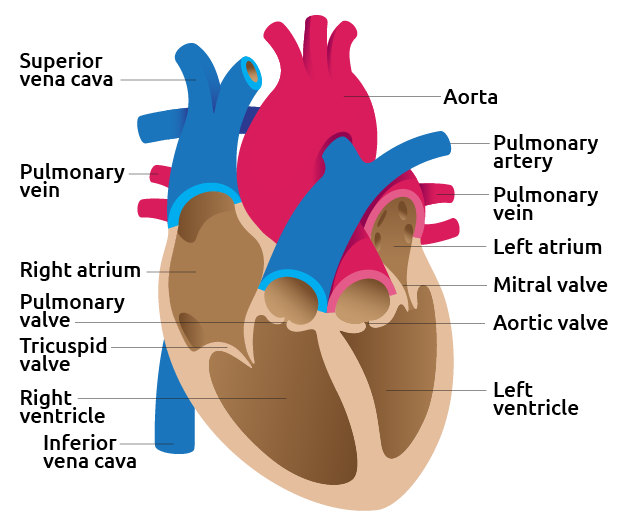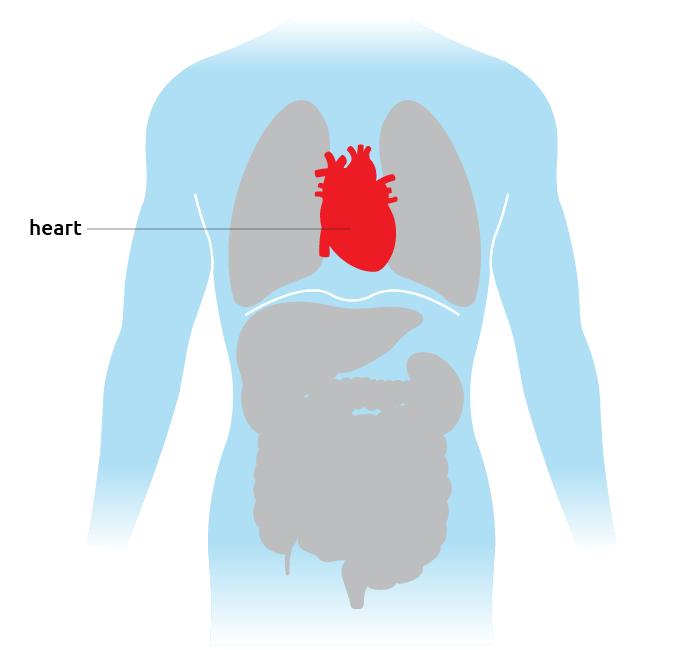Heart
COVID-19 FAQs and vaccine information
How does your heart work?
The heart is a strong and muscular organ that is about the size of a fist in adults. It pumps blood throughout the body and is located behind the breastbone between the lungs. Deoxygenated blood flows from the heart to the lungs where it gives up carbon dioxide and is freshly oxygenated. From there, the blood returns to the heart and is pumped to the rest of the body.
How does your heart work?
Your heart pumps blood throughout your body, bringing the oxygen and nutrients it needs. The heart also carries away waste. The heart works like a pump, or two pumps in one. The right side of your heart receives blood from the body and pumps it to the lungs.
Common heart diseases
Common diseases that may lead to transplantation include:
- Cardiomyopathy
- Heart failure
- Restrictive myopathy
- Coronary heart disease
About a heart transplant operation
In the four decades since the first human heart transplant occurred in 1967, the procedure has changed from an experimental operation to an established treatment for advanced heart disease. They are now the third most common organ transplant operation in the U.S.

Preparing for the hospital
Preparing for the hospital In preparing for your heart transplant surgery, use the following checklist to prepare for your procedure:
- Select your primary support person. Choose someone you feel close to who has the time, health, and flexibility to be your caregiver. You need to know you are not a burden to this person. For caregivers, follow this link for more information on caring for patients.
- Prepare a phone/email tree. This will make it easier for your caregiver to update friends and family while cutting down on phone or email volume.
- Organize your personal affairs. Consider filling out an advanced directive, writing a will, and sharing access to bank accounts, e-mail, or blogs with a trusted loved one. You may also need to fill out Family Medical Leave Act, insurance, or loan deferment paperwork.
- Consider dependent care. Find someone you trust and set up a plan to take care of your children and/or pets. Ask your doctor when you can expect to see your children and pets after your transplant.
- Arrange transportation. You will want to plan how to get to the transplant center quickly when you get the call that an organ is available. Be sure to make these arrangements well in advance. If you are relocating, make sure you make housing arrangements in advance.
- Pack your bags. You’ll need to be ready to leave as soon as you get the call that an organ is available. Include insurance information, a list of medications, an extra 24-hour supply of medication, and other necessities.

The procedure
There are two very different surgical approaches to heart transplantation: the orthotopic and the heterotopic approach. Because the length of this surgery is different for every patient, families should talk with the surgeon about what to expect.
- Orthotopic approach. The more common of the two procedures, the orthotopic approach, requires replacing the recipient heart with the donor heart. After the donor heart is removed, preserved and packed for transport, it must be transplanted into the recipient within four to five hours. The recipient receives general anesthesia and is placed on a bypass machine to oxygenate the blood while the heart transplant is being performed. After the recipient’s heart is removed, the donor heart is prepared to fit and implantation begins.
- Heterotopic approach. Heterotopic transplantation, also called “piggyback” transplantation, is accomplished by leaving the recipient’s heart in place and connecting the donor heart to the right side of the chest. The procedure is rare compared to orthotopic transplantation and is advantageous because the new heart can act as an assist device if complications occur. Your physician can explain why this approach may better suit your needs.

During recovery
Postoperative care begins with a team of health professionals within the hospital. Careful, comprehensive post-surgical monitoring constantly evaluates whether the body is accepting the new organ. In addition, the amount of time you spend in the recovery room, waking up and getting to the point that you’re ready to go home, will vary from patient to patient. Because individual experience after recovery is so unique, it is important to discuss with your physician what to expect after surgery.
Reference and Publication Information
This Web site is intended solely for the purpose of electronically providing the public with general health-related information and convenient access to the data resources. UNOS is not affiliated with any one product nor does UNOS assume responsibility for any error, omissions or other discrepancies.


